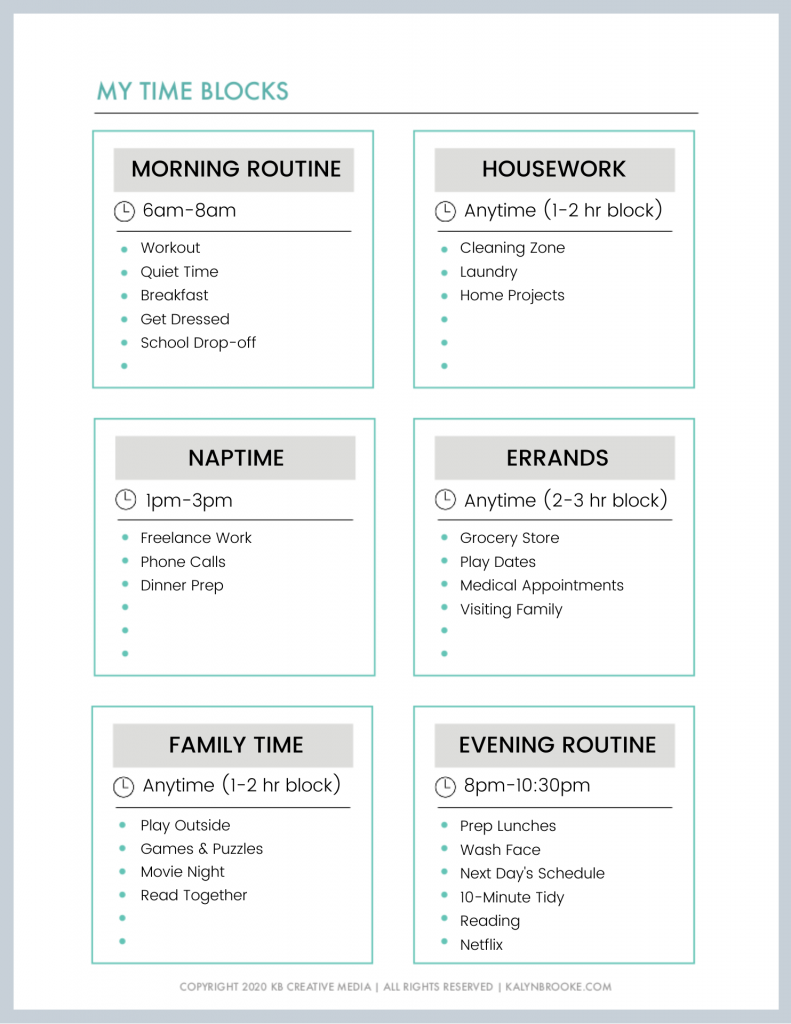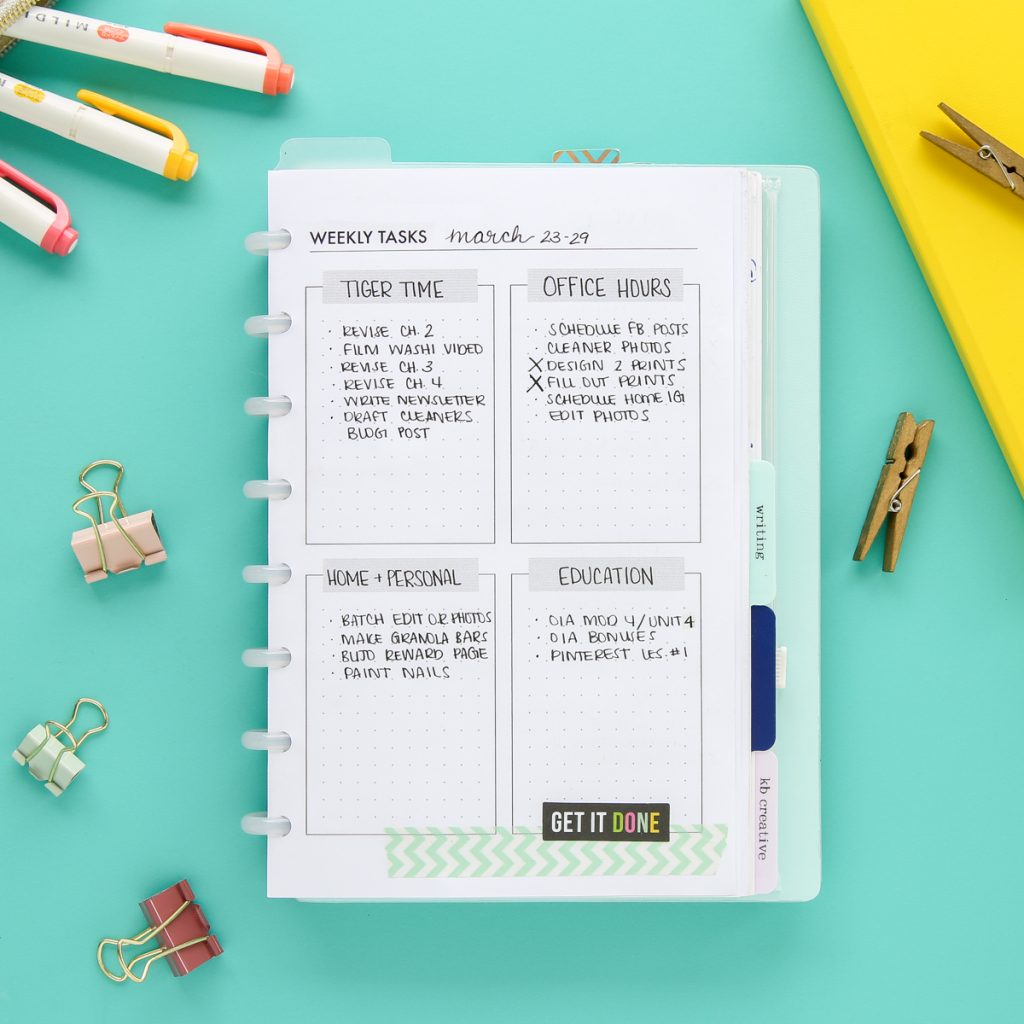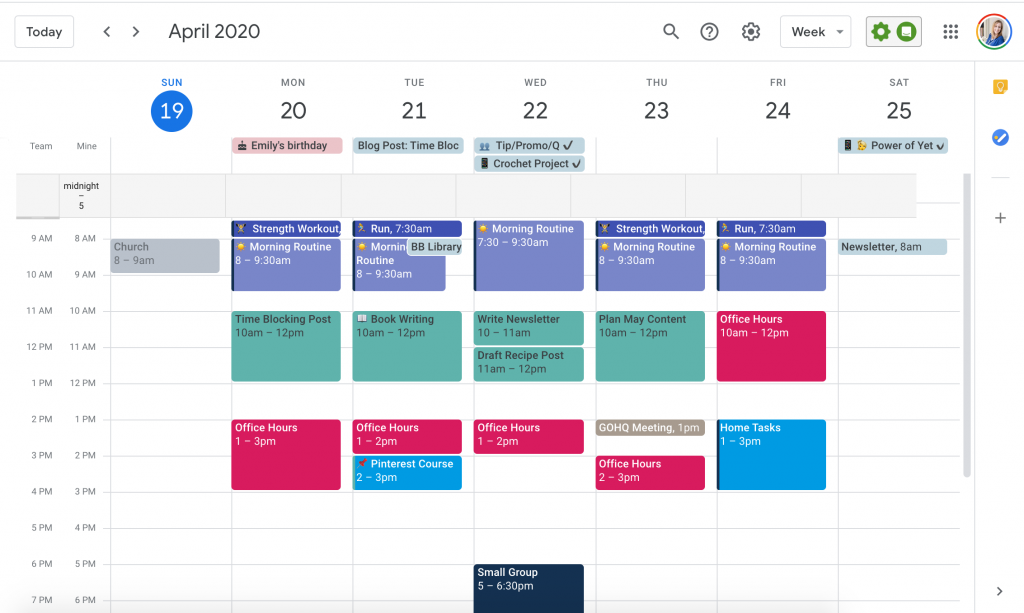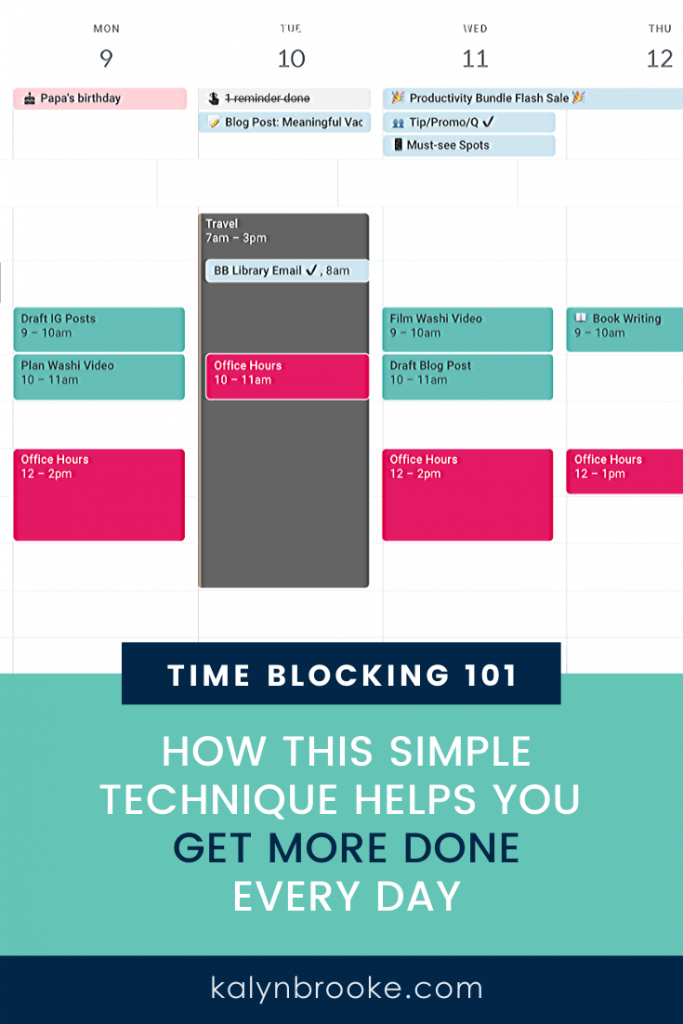How to Take Charge of Your Day with Time Blocking

After months of ending each day with unchecked tasks on my to-do list and making minimal progress toward my long-terms goals, something had to give.
I was making all the plans and writing all the lists, but it all it took was a few phone calls, texts, emails, and multiple browser tabs for me to feel pulled in a million directions.
I often scratched my head at 9pm, wondering where the day went and how I had managed to accomplish so little! I knew I needed a better time management schedule.
So when a friend recommended I try time-blocking, the efficiency nerd in me jumped at the chance to give this productivity method a shot.
Because the results she had? They spoke for themselves.
My friend accomplished more in a day than I was in a week. And while I definitely don’t have the unlimited energy she has (let’s just be real), I made MORE progress than I ever did before just by implementing this simple technique.

With time blocking, I was able to:
- Plan more easily. I knew exactly what to do and when. No more winging it!
- Say goodbye to distraction and give myself permission to focus on one task until it was complete.
- Be crazy efficient. With a set time to batch similar tasks, I didn’t have to spend extra time shifting out of one “task type” and into another.
You can experience the same results!
Time-blocking is especially helpful if you find yourself jumping around from task to task, leaving a string of half-finished projects in your wake… or you feel like you’re constantly playing defense against what feels urgent, but struggle to make progress on the things that will have the most impact.
In other words, you’ll become proactive about your time, rather than reacting to all the balls thrown your way. And at the end of the day, you’ll have margin to spare!
What IS Time Blocking?
A basic definition of time blocking is to “block off” portions of your day to focus on specific tasks. It’s that simple!
There are two types of time blocks – batched time blocking and detailed time blocking:
1. Batched Time Blocking
With this method, you look at the types of tasks that pop up in a typical week, then group those tasks into similar categories based on how you naturally segment your responsibilities.
This saves you from scheduling every little task, like folding laundry, into your calendar! You can just add it under the Housework time block along with meal prep and cleaning.
Also, by knocking out a bunch of similar tasks at once, you save a ton of time working in the same “mode” rather than jumping back and forth between unrelated tasks..
2. Detailed Time Blocking
On the other hand, you can use detailed time blocking to carve out a specific time to work on ONE task.
This detailed view comes in handy for calendar events that have specific start and end times, longer projects that require 100% focus, and tasks that won’t get done unless you assign them a time block (like a morning workout).
Bottom line: If you want the best chance to complete anything on your list, assign it a time block! I find that my most productive days use a combination of both.
online “Crash class”
Time Blocking: The Distraction-Free Way to Structure Your Day
More of a visual learner? Don’t miss this deep dive teaching about Time Blocking (the powerful productivity method you need to take back your day!)
Step 1: Create Your Time Blocks
To create time blocks specific to your schedule, pull out a scrap sheet of paper and first brainstorm everything you do in a typical day. EVERYTHING. Don’t hold back!
Then combine what you can into main categories to create your batched time blocks.
If you want to go one step further, you can also assign a time frame (ex. Morning Routine: 6am-8am) for where that block would best fit in your schedule. But you don’t have to! You can always change your block times depending on the day. That’s what I do!
Here are sample blocks to help you get started:

This is important: Each block is just a sampling of what you could do during that time block. For instance, the Housework block could be laundry one day and organizing a desk drawer another.
Time blocking is a framework! And it should be flexible enough for you to arrange as you please depending on the day.
These are my Four Major Blocks:
- Tiger Time. Amy Porterfield coined this term to illustrate how fiercely you should protect this time—like a mama tiger would her cub! I use this block to work on my writing projects or to do any strategic planning. Basically anything that requires major focus and no interruptions goes on this list. (Usually 10am-12pm)
- Office Hours. I tackle all administrative tasks and busy work during this block. Since this block allows for interruptions, I try to list items where I can easily pick up where I left off—things like editing photos, responding to emails, etc. (Sometime in the afternoon)
- Home + Personal. I dump anything outside of work onto this list. I don’t add any routine tasks (the crowded sink is reminder enough to wash the dishes!), but anything else I would like to get done that is above and beyond my everyday responsibilities gets added. (Anytime)
- Education. I’m a big believer in continual learning, so I’m always in the middle of a course or two. But I never set aside time to actually finish these courses until I time-blocked it! (Anytime)
I also block off set times each day for my Morning Routine and Evening Routine.
Remember that your time management schedule will probably look very different than mine (or your best friend’s or sister’s or mom’s!).
We all have very different schedules and responsibilities, which will be reflected in how we plan our time.
The time blocks for a mom with teenagers and a side-hustle start-up will look completely different from a stay-home-mom with two kids under four. One might divide her day into what she can accomplish during school hours, and the other would focus on what she can do during nap-time vs when her kids are awake.
Step 2: Create Your Weekly Schedule
Here’s where we dig into the nitty gritty.
At the beginning of each week (I do this on Sunday nights), brain dump everything you need and want to accomplish like you normally would. But instead of looking (and cringing!) over one massive to-do list, divide your tasks so they fall under your corresponding time blocks.
(Psst… you can get this Weekly Task Quad Printable—and 200+ more!—in the Brainbook Printable Library)

Next, grab ONE of these three tools:
- A planner with a weekly hour-by-hour layout (like the Erin Condren LifePlanner or Living Well Planner)
- A printable hour-by-hour schedule that you can insert into your planner or hang somewhere where you’ll see it often
- A digital calendar like Google Calendar
I currently use Google Calendar because it is super easy to move blocks around if a project takes longer than normal. AND if I mess up, this recovering perfectionist doesn’t have to deal with white-out tape. I just delete the block!

- With your weekly tasks already categorized by time blocks, open up your tool of choice and mark down any fixed, must-do appointments and events. Since these are immovable, they must be added first.
- Then add in your batched time blocks (1-3 hour chunks) everywhere else. Color code if you want!
- Lastly, pull out any tasks from your list that require extra time or focus, and create a separate detailed time block for those.
FYI: With this time management schedule, you do not want to fill every hour of your day with time blocks. That’s a fast track to feeling like your whole day is ruined if you have a project that runs 15 minutes overtime. Life happens! Not even Enneagram 3’s can keep to that rigid of a schedule, so you shouldn’t expect that of yourself either. 🙂
Step 3: Write your daily to-do list
The last step is to look over your schedule the night before, adjust as needed, then write out your next day’s to-do list based what you’ll do within each block.
I’ll show you a few examples!
Example #1
Below is a daily page from one of my past bullet journals. You can see that every task has a color-coded block next to it, signifying which time of day I wanted to work on that task.

What I like about this layout is you don’t need to write your to-do list in order of your time blocks. Just color code them to easily see what you need to do and when!
Example #2
Here’s another one:
This journal is from Christina at Square Lime Designs. She also color coded her time blocks, but instead of a linear list, she slides her tasks under each section.
Interested in starting your own bullet journal? Check out my comprehensive starter guide HERE.
Example #3
If bullet journaling isn’t your thing, you can use this same method in a regular planner.
The Erin Condren Petite Planner (as illustrated by Jen_Plans) allows you to list out each hour of the day, OR use those title boxes to define your time blocks and write down what tasks you’ll tackle under each.
How to Apply This Time Management Schedule Successfully:
The following hacks will supercharge the time-blocking method and help you get the most out of it.
1. Limit your time blocks. (I would suggest no more than six.) It’s better to have a few “set” start times throughout your day with margin in between than to feel like you have to keep a perfect schedule.
2. Tailor your time blocks to how your energy levels ebb and flow throughout the day. For me, the two-hour window from 10am-12pm every day is when I’m most awake and able to concentrate. That makes it the perfect place to add a Tiger Time block. But by 3pm, I’m losing steam, which is why I tackle things like email in the afternoons instead of bigger projects that require major attention.
3. Always schedule in more time than you think the task or project will take. This eliminates overwhelm AND disappointment when you get interrupted or don’t get everything done like you thought you would. The best way to plan is to plan for reality!
4. Set timers, but only if they WON’T stress you out! Use your built-in phone reminders to ding 15 minutes before a block is done as a reminder to wrap things up and get ready for the next block.
Want to level up your productivity? Try combining time-blocking with this Pomodoro Timer App!
5. Leave lots of white space in between blocks. Give yourself transition time periods between blocks and add “buffer blocks” where you don’t have anything scheduled. This will help you maintain a realistic plan of action for your day.
After your first successful week of time blocking, you’ll quickly understand why this time management schedule is a game-changer. Instead of feeling anxious about how much you have to get done, you’ll become strategic and intentional about your approach.
And when Friday afternoon arrives, you can bask in the glory of all you accomplished without dreading having to spend your entire Saturday playing catch-up!
Let’s chat about time blocking:
Have you ever tried this productivity method before? What would be your time blocks?
Pin this post to reference later:



Disclosure: Some of the links in the post above are affiliate links. This means if you click on the link and purchase the item, I will receive an affiliate commission. Regardless, I only recommend products or services I use personally and believe will add value to my readers. Read my full disclosure policy here.




I’m trying this with the kids this week. I’ve been creating a schedule for each one of us, then one for me. Something hasn’t been working with it, though, and I think it’s the rigidity of it. Thanks to this post, we’re trying time blocking to see if it offer the flexibility that we need. We’ll see how it goes!
I hope it helps!
I’ve used this method for over forty years and still do now that I’m bullet journaling. I started while a student at UCLA and needed a plan to get my schoolwork done and also get to my part-time job daily. I found that if I set aside a particular block of time on a particular day, I could complete the task during that time period. I think a lot of it is psychological, but who cares, if it works. For example, I would set aside three hours on Thursday in which to outline and draft a paper that was due on Monday, and that’s exactly how long it would take me! Then I would set aside two hours on Friday to revise and proofread, and that’s exactly how long it would take me. Finally, I would plan to type it at the library on Monday in a two hour block, and turn it in later that day. Of course, it’s much easier now with computers, but the mind will adjust its pace and performance to the time allotted to the task.
Yes!! Work always expands to the amount of time you have available! I love that you were able to find success with this method even years ago.
Hi, Kalyn! It looks like all of the download links on this page are broken–would love to be able to download the worksheets!
Oh no! Thanks for giving us a heads up. If you send an email to [email protected], we’ll be sure to get you those printables!
I love how much detail you go into in this post! I definitely want to try this out. I already tried doing a time log, to see how I spent my time for a week, so now I want to try this out to see how much more productive I can be! 🙂
– Pixie | Productive Pixie
I think you’ll love it!!